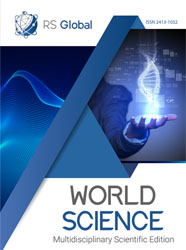DECISION MAKING UNDER LINGUISTIC UNCERTAINTY CONDITIONS ON BASE OF GENERALIZED FUZZY NUMBERS
Abstract
This article is devoted to the problem of decision making under linguistic uncertainty. The effective method for modelling linguistic uncertainty is the fuzzy set theory. There are several types of fuzzy number types proposed by L. Zadeh: fuzzy type-1, fuzzy type-2, Z-numbers. Chen proposed concept of generalized fuzzy numbers. Generalized trapezoidal fuzzy numbers (GTFN) one of effective approach which can be used for modeling linguistic uncertainty. GFTN very convenient model which allow take in account second order uncertainty. GFTN are formalized and major operations are described as practical problem is considered group decision making for supplier selection. In this case the criteria assessments are expressed by experts in linguistic form. Group decision making model is presented as 2 step aggregation procedure, in first step is aggregated value of alternative by expert, in second step by criteria. Numerical example with four criteria and three alternatives are presented and solved.
References
L.A. Zadeh (1965), "Fuzzy sets," Information and Control, vol. 8, pp. 338-353. Retrieved from https://doi.org/10.1016/S0019-9958(65)90241-X
L.A. Zadeh (1975), The concept of a linguistic variable and its application to approximate reasoning – I, Information Sciences 8 (3), p. 199–249. Retrieved from https://doi.org/10.1016/0020-0255(75)90036-5
Chen, S. H. (1985), Operations on fuzzy numbers with function principal. Tamkang Journal of Management Sciences,6, p. 13-25. Retrieved from https://doi.org/10.1016/S0020-0255(97)10070-6
Zadeh, L. A. (2011), A note on Z-numbers. Information Science 181, p. 2923–2932. Retrieved from https://doi.org/ 10.1016/j.ins.2011.02.022
L.A. Zadeh (1999), "From computing with numbers to computing with words—from manipulation of measurements to manipulation of perceptions," IEEE Trans. on Circuits and Systems–1, Fundamental Theory and Applications, vol. 4, p. 105–119. Retrieved from https://doi.org/10.1007/978-3-7908-1792-8_5
Y. L. P. Thorani, P. Phani Bushan Rao, and N. Ravi Shankar (2012), Ordering Generalized Trapezoidal Fuzzy Numbers, Int. J. Contemp. Math. Sciences, Vol. 7, no. 12, p. 555 – 573.
J.M. Mendel, R.I. John, F. Liu (2006), Interval type-2 fuzzy logic systems made simple, IEEE Transactions on Fuzzy Systems 14 (6), p.808–821. Retrieved from http://dx.doi.org/10.1109/TFUZZ.2006.879986
Banerjee S., Kumar T. (2012), Arithmetic Operations on Generalized Trapezoidal Fuzzy Number and its Applications, Turkish Journal of Fuzzy Systems (eISSN: 1309–1190) Vol.3, No.1, p.16-44.
M.J. Tsai, C.S. Wang (2008), A computing coordination based fuzzy group decision making for web service oriented architecture, Expert Systems with Applications 34 (4), p. 2921–2936. Retrieved from https://doi.org/10.1016/j.eswa.2007.05.017
J. Ma, J. Lu, G. Zhang (2010), Decider: a fuzzy multi-criteria group decision support system, KnowledgeBased Systems 23 (1), p. 23–31. Retrieved from https://doi.org/10.1016/j.knosys.2009.07.006
I.J. Perez, F.J. Cabrerizo, E. Herrera-Viedma (2011), Group decision making problems in a linguistic and dynamic context, Expert Systems with Applications 38 (3), p. 675–1688. Retrieved from https://doi.org/10.1016/j.eswa.2010.07.092
Z.S. Xu (2011), Approaches to multi-stage multi-attribute group decision making, International Journal of Information Technology and Decision Making 10 (1), p.121–146. Retrieved from https://doi.org/10.1142/S0219622011004257
J. Pang, J. Liang (2012), Evaluation of the results of multi-attribute group decision making with linguistic information, Omega-International Journal of Management Science 40 (3), p.294–301. Retrieved from https://doi.org/10.1016/j.omega.2011.07.006
S.-M. Chen, L.-W. Lee (2010), Fuzzy multiple criteria hierarchical group decision making based on interval type-2 fuzzy sets, IEEE Transactions on Systems, Man and Cybernetics, Part A: Systems and Humans 40 (5), p. 1120–1128. Retrieved from https://doi.org/10.1109/TSMCA.2010.2044039
Views:
295
Downloads:
208
Copyright (c) 2021 Salimov Vagif Hasan Oglu

This work is licensed under a Creative Commons Attribution 4.0 International License.
All articles are published in open-access and licensed under a Creative Commons Attribution 4.0 International License (CC BY 4.0). Hence, authors retain copyright to the content of the articles.
CC BY 4.0 License allows content to be copied, adapted, displayed, distributed, re-published or otherwise re-used for any purpose including for adaptation and commercial use provided the content is attributed.











